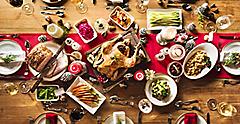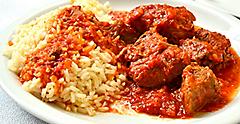Come with me off-the-beaten-path through some of Italy's best, lesser-known mom-and-pop eateries, bakeries, and gelaterias. You can plan for those blow-out meals ahead of time, but sometimes, it's the meandering paths that lead to culinary nirvana.
Bologna: The Red, The Fat, And The Learned
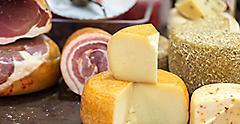

Run by extrovert Dante and daughter Barbara Casari, Papa Re is a small, intimate trattoria that offers the ideal example of the simple perfection that is Bolognese; the sauce almost vapor-light and clinging like a glaze to the fresh, handmade tagliatelle as if they were made for each other. As we ate, Dante introduced himself and sat at our table a while, regaling us with stories of his past, his love for the Caribbean and his fascination with Cuban culture. This is a man clearly in his element when engaging with diners; he made us feel like old friends. Often the warm ambiance is made complete by a local Italian musician. It's an experience you can only get at an authentic Italian hole-in-the-wall.
Our meal was capped off with a small glass of U Pasa, a sweet local wine made from slightly dehydrated grapes. I was so enamored with it and raved about it all night. At the end of the meal, Dante gifted me a bottle to take home, along with memories that are still fresh in my mind as I write.
Navigating The Busy Streets As You Visit Venice On Vacation
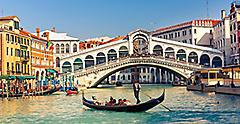
There are many, many tourists in Venice, and understandably so. Avoiding tourist traps is an art perhaps more than a science, and by being aware of our surroundings and avoiding some tell-tale signs, we managed to navigate successfully between feasting our eyes on world-renowned art and nourishing our bodies at lesser-known establishments. Eating near any of the major sights in Venice usually leads to gastronomical disappointment, as the restaurants are usually pricey and crowded.
The first thing to note is that age-old adage about paying for the view at the cost of your food. As our trip was planned around a food vacation (really!), we decided to separate our sightseeing from our mealtimes. As a general rule, avoid restaurants with multilingual menus and pictures of their dishes, and look for restaurants that actually close before dinner. Many tourist-focused eateries will stay open throughout the day — though this is not what most quality restaurants in Italy will do.
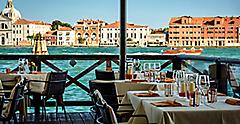
When we needed a coffee break after seeing Piazza San Marco, we left the magnificent square and wandered around the smaller streets. Spotting a construction crew packing up for a break, we knew we were onto something when they all disappeared en masse down a little alley and into a nondescript coffee shop. We followed and were pleasantly surprised by the quality of the coffee, the selection of pastries, and, importantly, the prices. Without lurking around Venice looking for construction crews, I suggest you speak to a local and ask them where they like to eat. (Note: Don't ask them where they think you should eat — that will get you a very different answer.)
Eating locally as you travel in Italy will always guarantee a quality meal. In the case of Venice, seafood is usually a good option, as are the multiple bacari (taverns/wine bars) serving substantial snacks and drinks. Bacari are usually located off the beaten track, small, dark, and wood-furnished, and packed with locals enjoying an Aperol spritz and some variation of fritters, though sandwiches are also popular, as is raw seafood — the perfect pick-me-up for lunch or a late afternoon snack. El Sbarlefo is famous for its Baccala Mantecata (whipped salted cod), often served on polenta, while the seafood choices at Osteria La Vedova are second to none, with wine served in traditional Venetian carafes.
Florence Travel: Enjoying The Local Foods In Firenze

Before we left the north, there was an important to make time to travel in Florence, that Renaissance city of exquisite sculptures, with the Uffizi and awe-inspiring Duomo dominating the skyline. For us, this was also a chance to stop in at the San Lorenzo food market, the epicenter of local producers ranging from Tuscan olive oils, hand-crafted pasta, baked goods, truffles, local meat, and produce to honey and other sweets. Truly a sample of eating in Italy.
It's surrounded by leather merchants (I have a purse I bought there over a decade ago that's still in great shape!) and just in front, a truly exceptional food cart selling lampredotto sandwiches sits unassumingly. This most Tuscan of dishes is as humble as it gets — essentially beef stomach stuffed into a sandwich — but before I sense you skipping to the next paragraph, let me add that tripe or offal is not high on my list of favorite foods, either. We approached the cart with trepidation, but the vendor assured us that we would be wowed. So, we drew up the courage to take a bite, and then: absolute wonder. The fourth stomach is nothing like regular tripe; it gets stewed in tomatoes, celery, parsley, and onions until it's so soft you could eat it with a spoon. Typically served with a spicy salsa verde, the crusty bun yields to a saucy, spicy beefy mouthful that is so good, you should consider this a mandatory food stop when near the San Lorenzo.
A second floor was added to the market in 2014 in order to create a food hall, where chefs are able to source premium products downstairs and present them on their menus mere minutes later. There are sit-down options in the food hall as well, with restaurants generally featuring local specialties (if the lampredotto sandwich outside doesn't appeal).
Rome Travel: Eating Locally In The Eternal City
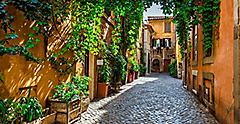
In Rome, we stayed in Trastevere, on the "non-touristy" side of the Tiber River, to get a more authentic taste of Roman life. For breakfast, there generally is no sit-down experience to speak of as Romans like to start their day with a java and sugar jolt standing, en route to work. When in Rome, head to one of the many little coffee shops tucked away on a cozy street. You pay for your order upon entry, obtain a receipt and wait at the main counter where you place your receipt face down. The staff constantly walk up and down the counter, flipping the receipts to fulfill the order. Purchase a house-baked cornetti (pastry) or two, a cappuccino or espresso, and sit on a nearby park bench and people-watch. Find a maritozzi, little yeasted buns that are sometimes filled with panna (cream) and are absolutely delicious. Pasticceria Regoli makes a fine one! Try and avoid ordering cappuccino or milk-based coffee after 11 a.m. since these are considered breakfast drinks.
I would be remiss to leave Rome without trying one of its arguably greatest culinary inventions: the pasta carbonara. Typically served over spaghetti, the sauce is creamy and made with eggs, Pecorino Romano cheese, guanciale (cured pork cheek), and black pepper. As we found ourselves in the beautiful Campo dei Fiori square, we headed to one of the leading exponents of this dish, the appropriately named La Carbonara. The outdoor dining area allows for prime people-watching, the pasta was creamy yet not heavy. Salty specks of guanciale punctuated each mouthful, accompanied by flecks of black pepper. Enjoy the patio, the warm sun and a chilled glass of Italian pinot grigio.
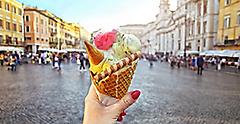
Beyond The Seafood In Sorrento On Your Food Vacation
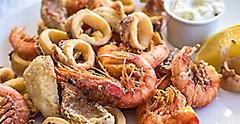
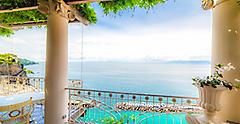
You can spend hours preparing for your Italian vacation by poring through Yelp reviews, planning out every meal, and making sure you hit every spot you've been recommended. But, there's a magic to being spontaneous. Often the most incredible experiences happen when you least expect them. You may meet the kindest restaurant owner at the tiny bistro you stumble upon on a walk or have the best meal of your life at an off-hand recommendation from a bus driver. Finding excellence in the unexpected is what makes Italy such a special place.
Celebrate life with a Food Vacation while Traveling on an Italy Cruise.
Get Royal Deals, Sign Up Today

Getting There
Explore our most afforadable itineraries
Cruise to Italy and indulge in some of the country’s finest cuisine.



